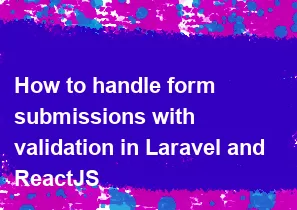How to handle form submissions with validation in Laravel and ReactJS

Handling form submissions with validation in Laravel and ReactJS involves a combination of server-side and client-side validation. Laravel takes care of server-side validation, while ReactJS handles client-side validation and manages the form state. Here's a step-by-step guide on how you can achieve this:
Laravel Backend (Server-side):
Create a Controller: Create a controller that handles form submissions and validation.
bashphp artisan make:controller FormControllerDefine Validation Rules: In your
FormController, define the validation rules in thestoremethod.phppublic function store(Request $request) { $validatedData = $request->validate([ 'name' => 'required|string|max:255', 'email' => 'required|email|unique:users|max:255', // Add more validation rules as needed ]); // Handle form submission logic here // Save data to the database, send emails, etc. }Handle Form Submission: Implement the logic to handle the form submission in the
storemethod.phppublic function store(Request $request) { $validatedData = $request->validate([ 'name' => 'required|string|max:255', 'email' => 'required|email|unique:users|max:255', // Add more validation rules as needed ]); // Handle form submission logic here // Save data to the database, send emails, etc. }Return JSON Response: Return a JSON response with appropriate messages for success or failure.
phpreturn response()->json(['message' => 'Form submitted successfully'], 200);
ReactJS Frontend (Client-side):
Create a Form Component: Create a React component for your form. Manage form state using React hooks (e.g.,
useState).jsximport React, { useState } from 'react'; const MyForm = () => { const [formData, setFormData] = useState({ name: '', email: '', // Add more form fields as needed }); const handleChange = (e) => { setFormData({ ...formData, [e.target.name]: e.target.value, }); }; const handleSubmit = (e) => { e.preventDefault(); // Perform client-side validation if needed // Send data to Laravel backend fetch('/api/form', { method: 'POST', headers: { 'Content-Type': 'application/json', }, body: JSON.stringify(formData), }) .then(response => response.json()) .then(data => { console.log(data.message); }) .catch(error => { console.error('Error:', error); }); }; return ( <form onSubmit={handleSubmit}> {/* Form fields with input and onChange handlers */} <input type="text" name="name" value={formData.name} onChange={handleChange} /> <input type="email" name="email" value={formData.email} onChange={handleChange} /> {/* Add more form fields as needed */} <button type="submit">Submit</button> </form> ); }; export default MyForm;Client-side Validation (Optional): If you need client-side validation, you can add validation checks in the
handleChangeorhandleSubmitfunctions.jsxconst handleSubmit = (e) => { e.preventDefault(); // Perform client-side validation if (!formData.name || !formData.email) { console.error('Please fill out all required fields'); return; } // Send data to Laravel backend // ... };Integrate React Component: Integrate the React component into your application where needed.
jsximport React from 'react'; import MyForm from './MyForm'; const App = () => { return ( <div> <h1>Your App</h1> <MyForm /> </div> ); }; export default App;Setup Laravel Routes: Define a route in
web.phporapi.phpfile to handle the form submission.php// routes/web.php or routes/api.php use App\Http\Controllers\FormController; Route::post('/api/form', [FormController::class, 'store']);
Now, when the form is submitted, it will send a request to the Laravel backend, where server-side validation will be performed, and appropriate JSON responses will be returned. Adjust the code according to your specific form fields and validation requirements.
-
Popular Post
- How to optimize for Google's About This Result feature for local businesses
- How to implement multi-language support in an Express.js application
- How to handle and optimize for changes in mobile search behavior
- How to handle CORS in a Node.js application
- How to use Vue.js with a UI framework (e.g., Vuetify, Element UI)
- How to configure Laravel Telescope for monitoring and profiling API requests
- How to create a command-line tool using the Commander.js library in Node.js
- How to implement code splitting in a React.js application
- How to use the AWS SDK for Node.js to interact with various AWS services
- How to use the Node.js Stream API for efficient data processing
- How to implement a cookie parser middleware in Node.js
- How to implement WebSockets for real-time communication in React
-
Latest Post
- How to implement a dynamic form with dynamic field styling based on user input in Next.js
- How to create a custom hook for handling user interactions with the browser's device motion in Next.js
- How to create a custom hook for handling user interactions with the browser's battery status in Next.js
- How to implement a dynamic form with dynamic field visibility based on user input in Next.js
- How to implement a dynamic form with real-time collaboration features in Next.js
- How to create a custom hook for handling user interactions with the browser's media devices in Next.js
- How to use the useSWRInfinite hook for paginating data with a custom loading indicator in Next.js
- How to create a custom hook for handling user interactions with the browser's network status in Next.js
- How to create a custom hook for handling user interactions with the browser's location in Next.js
- How to implement a dynamic form with multi-language support in Next.js
- How to create a custom hook for handling user interactions with the browser's ambient light sensor in Next.js
- How to use the useHover hook for creating interactive image zoom effects in Next.js